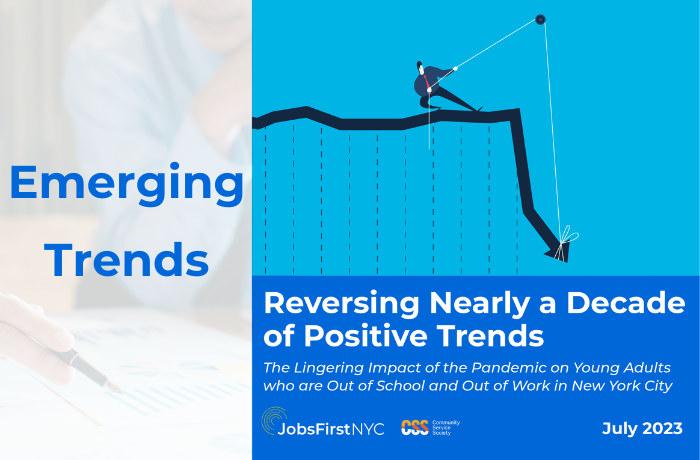More Findings from Reversing a Decade of Positive Trends: The Lingering Impact of the Pandemic on Young Adults Who are Out of School and Out of Work in New York City
In July 2023, JobsFirstNYC, in partnership with Community Service Society of New York (CSS), published Reversing A Decade of Positive Trends: The Lingering Impact of the Pandemic on Young Adults Who Are Out of School, Out of Work in New York City, a new data brief that explored the state of 16- to 24-year-old New Yorkers who are out of school and out of work. The brief drew on data from the U.S. Census and the City of New York to examine the out-of-school, out-of-work population from a variety of socioeconomic and demographic perspectives. It also identified programs and policies that seek to address the needs of this population, and lifted up recommendations to ensure they are put back on track to economic security. Here are some of the broader issues that JobsFirstNYC is following closely, as we believe they will have an increasing impact on NYC’s young people.
Broader Issues to Explore Affecting Young Adults in New York City
Increased out-of-school, out-of-work rates in Manhattan and Queens
Out-of-school, out-of-work population rates increased the most in Manhattan and Queens. Meanwhile, Manhattan and Queens have fewer New York City Department of Youth and Community Development program sites and workforce program sites than other boroughs.
Low first-time postsecondary enrollment
Nationally, there were more than one million fewer undergraduates enrolled in college in 2021 compared to fall 2019, according to data released by the National Student Clearinghouse Research Center. These unprecedented drops in college enrollment signal that young adults may be reconsidering the value of college. JobsFirstNYC’s Education Solutions is addressing this trend by building equitable pathways to postsecondary education and career pathways, for example through the long-standing Bronx Opportunity Network partnership between Bronx-based community-based organizations and colleges.
Rise of part-time jobs and the gig economy
In New York State, 850,000 workers are low-wage independent contractors, according to The Center for New York City Affairs. Because these workers are not classified as employees, they lack the guaranteed protections that are afforded to most workers, including a minimum wage, basic insurances, paid sick leave, and the ability to form labor unions. As the gig economy spreads to new sectors, advocates are calling for clearer legislation on protections for independent contractors and an end to the rampant misclassification of workers. JobsFirstNYC’s Work Solutions has launched three citywide Sector Networks in the green economy, tech, and healthcare. These Networks will strengthen collaboration among workforce training providers and employers to improve program design and skills training, leverage knowledge and resources, and increase access to higher-quality jobs.
Lack of college degrees creates a barrier to accessing economic mobility
Young adults who are out of school and out of work are reaching a paper ceiling: the invisible barrier that comes at every turn for workers without a bachelor’s degree. Almost 75% of young adults who are out of school and out of work have no college education, restricting their opportunities in the job market. This is why JobsFirstNYC has launched the Skills Mapping Academy, powered by Quantum Labor Analysis pioneer, SkyHive. Skills Mapping uses real-time labor market intelligence to understand the skills people have, the skills they need to succeed in the workforce – now and in the future, and how to bridge the gap. This will serve to train, upskill and re-skill individuals and communities at speed and scale to expand pathways to job opportunities and economic mobility.
Low rates of household formation
As the cost of living in NYC continues to rise, young people are living with their parents for longer and buying homes at lower rates than previous generations did at their age. Rent costs in New York City have recently hit record highs. Half of Americans aged 18-29 were living with their parents as of July 2022, according to a Pew Research Center analysis of Census Bureau data. Lack of choice, longer commute times, living far from friends and community spaces all contribute to the high rates of social isolation and loneliness among young adults today. At the same time, living at home with their families enables young people to accrue savings for themselves and their families, and take more time to develop and pursue their career goals.
Influx of new arrivals
There are 21,000 asylum-seeking students enrolled in NYC public schools as of September 2023. NYC direct service organizations face challenges in connecting undocumented workers and asylum seekers to workforce development opportunities, including paid internships and job placements. This will be a continued challenge and opportunity, as New York is currently hosting 59,400 asylum seekers as of August 2023.
Impacts of the increasing cost of living in NYC
50% of working-age households do not have earnings that meet the minimum cost of living in New York City, according to the Fund for the City of New York. Many New York City residents, particularly Black residents, are leaving the city due to the ever-increasing cost of raising a family in New York. This trend of migration has wide-ranging implications for the workforce, with labor shortages in industries including healthcare, food service and hospitality, where Black workers have traditionally been overrepresented. It is critical to ensure that community members are not displaced by economic development and gentrification in their neighborhoods. JobsFirstNYC’s Community Solutions creates localized solutions that respond to the unique needs of neighborhood communities with high numbers of young adults who are out of school and out of work, and are driven by the communities themselves to ensure that investment into the community serves those most in need.
We will continue to monitor these trends as we work together with stakeholders across the City of New York to get young adults who are out of school and out of work back on track to economic security.





